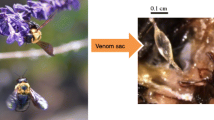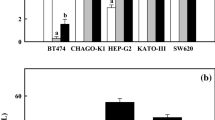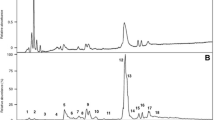Abstract
Two novel biologically active peptides, Eumenine mastoparan-OD and Orancis-Protonectin, were isolated from a solitary wasp, Orancistrocerus drewseni drewseni (Eumeninae, Vespidae). MALDI-TOF MS analysis of a small amount of the crude venom gave two intensive molecular-related ion peaks at m/z 1269.9 and 1552.9 that were expected to be novel based on a peptide database search. Purification of the crude venom by HPLC gave two peptide fractions, P-1 and P-2. The amino acid sequence of P-1 (GRILSFIKAGLAEHL-NH2) and P-2 (ILGIITSLLKSL-NH2) were determined by ESI-MS/MS, automated Edman degradation, and amino acid analysis. According to the high sequence homology with those of mastoparan and protonectin, P-1 and P-2 were labeled Eumenine mastoparan-OD and Orancis-Protonectin, respectively. Orancis-Protonectin is the first example of a protonectin analog isolated from the venom of a solitary wasp. The hemolytic activities of these new peptides were more potent than that of mastoparan.





Similar content being viewed by others
References
Carpenter JM (1982) The phylogenetic relationships and natural classification of the Vespoidea (Hymenoptera). Syst Entomol 7:11–38
Dohtsu K, Okumura K, Hagiwara K, Palma MS, Nakajima T (1993) Isolation and sequence analysis of peptides from the venom of Protonectarina sylveirae (Hymenoptera-Vespidae). Nat Toxins 1:271–276
Grimaldi D, Engel MS (2005) Evolution of the insects. Cambridge University Press, Hong Kong
Gullan PJ, Cranston P (2005) The insects, 3rd edn. Blackwell Publishing, California
Habermann E (1972) Bee and wasp venoms. Science 177:314–322
Haux P (1969) The amino-acid seqence of a specific mast cell degranulationg peptide of bee venom. Z Physiol Chem 350:536–546
Hines HM, Hunt JH, O’Connor TK, Gillespie JJ, Caeron SA (2007) Multigene phylogeny reveals eusociality evolved twice in vespid wasps. Proc Natl Acad Sci USA 104:3295–3299
Hirai Y, Yasuhara T, Yoshida H, Nakajima T, Fujino M, Kitada C (1979) New mast-cell degranulating peptide mastoparan in the venom of Vespula-lewisii. Chem Pharm Bull 27:1942–1944
Ho CL, Lin YL, Chen WC, Hwang LL, Yu HM, Wang KT (1996) Structural requirements for the edema-inducing and hemolytic activities of mastoparan B isolated from the hornet (Vespa basalis) venom. Toxicon 34:1027–1035
Konno K, Hisada M, Naoki H, Itagaki Y, Kawai N, Miwa A, Yasuhara T, Morimoto Y, Nakata Y (2000) Structure and biological activities of eumenine mastoparan-AF (EMP-AF), a new mast cell degranulating peptide in the venom of the solitary wasp (Anterhynchium flavomarginatum micado). Toxicon 38:1505–1515
Konno K, Hisada M, Naoki H, Itagaki Y, Fontana R, Rangel M, Oliveira JS, s Cabrera MP, Ruggiero NJ, Hide I, Nakata Y, Yasuhara T, Nakajima T (2006) Eumenitin, a novel antimicrobial peptide from the venom of the solitary eumenine wasp Eumenes rubronotatus. Peptides 27:2624–2631
Konno K, Rangel M, Oliveira JS, dos Santos Cabrera MP, Fontana R, Hirata IY, Hide I, Nakata Y, Mori K, Kawano M, Fuchino H, Sekita S, Ruggiero N (2007) Decoralin, a novel linear cationic alpha-helical peptide from the venom of the solitary eumenine wasp Oreumenes decoratus. Peptides 28:2320–2327
Mendes MA, de Souza BM, Marques MB, Palma MS (2004) Structural and biological characterization of two novel peptides from the venom of the neotropical social wasp Agelaia pallipes pallipes. Toxicon 44:67–74
Murata K, Shinada T, Ohfune Y, Hisada M, Yasuda A, Naoki H, Nakajima T (2006) Novel biologically active peptides from the venom of Polistes rothneyi iwatai. Biol Pharm Bull 29:2493–2497
Nagai H, Takuwa K, Nakao M, Ito E, Miyake M, Noda M, Nakajima T (2000) Novel proteinaceous toxins from the box jellyfish (sea wasp) Carybdea rastoni. Biochem Biophys Res Commun 275:582–588
Nakajima T (1993) Bio-organic elucidation of active principles of nonmammalian origin. Yakugaku Zasshi 113:114–132
Nakajima T (2006) Nanoanalysis of the arthropod neuro-toxins. Proc Jpn Acad Ser B Phys Biol Sci 82:297–310
Nakajima T, Yasuhara T, Yoshida H, Ueno Y, Otsuka C, Hamamoto M, Nobumori M, Hirai Y (1984) Waspkinins of some Japanese wasps Vespidae Hymenoptera. Med Entomol Zool 35:139–148
Nakajima T, Naoki H, Corzo G, Dai L, Hisada M, Escoubas P, Yamaji N, Nagai H, Yasuda A, Andrianstiferana M, Haup J, Ohsiro N (2003) A trial of mass spectrometric characterization of femto-molar amount from subtropical islands. J Toxicol Toxin Rev 22:509–520
Piek T (1986) Venoms of the Hymenoptera, biochemial, pharmacological and behavioral aspects. Academic Press, London
Piek T (1999) Animal toxins. In: Rochat H, Martin-Eauclaire MF (eds) Birkhäuser Verlag, Basel, pp 99–115
Sforca ML, Oyama S Jr, Canduri F, Lorenzi CCB, Pertinhez TA, Konno K, Souza BM, Palma MS, Ruggiero NJ, Azevedo WF Jr, Spisni A (2004) How C-terminal carboxyamidation alters the biological activity of peptides from the venom of the eumenine solitary wasp. Biochemistry 43:5608–5617
Souza BM, Mendes MA, Santos LD, Marques MR, Cesar LMM, Almeida RNA, Pagnocca FC, Konno K, Palma MS (2005) Structural and biological characterization of three novel mastoparan peptides from the venom of the neotropical social wasp Protopolybia exigua (Saussure). Peptides 26:2157–2164
Tu AT (1984) Handbook of natural toxin, vol 2. Mercel Dekker Inc, New York
Acknowledgments
We are grateful to Prof. K. Gokon of Tohoku Gakuin University for the discussion about the morphological aspects of wasps. This study was supported by the Research for the Future Program from the Japan Society for the Promotion of Science (JSPS 99L01204).
Author information
Authors and Affiliations
Corresponding author
Rights and permissions
About this article
Cite this article
Murata, K., Shinada, T., Ohfune, Y. et al. Novel mastoparan and protonectin analogs isolated from a solitary wasp, Orancistrocerus drewseni drewseni . Amino Acids 37, 389–394 (2009). https://doi.org/10.1007/s00726-008-0166-y
Received:
Accepted:
Published:
Issue Date:
DOI: https://doi.org/10.1007/s00726-008-0166-y




